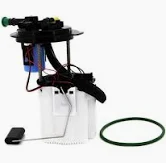The vehicle won't run at all without a fuel pump relay telling it where to send power, and therefore how much of that precious gasoline in the tank is siphoned off into consumption. The fuel pump relay then takes the ignition signal, and provides that to a switch that turns high current for the fuel pump on/off. The ignition in your car will run a small 12v electrical current to the relay for it just as you turn that key. The relay then finishes the circuit allowing high current, usually around 10-15 amps to flow directly from it to power up the fuel pump and deliver gasoline into your engine.
Thus, keeping the pump cool and turning it off when not in use prevents it from running non stop causing an early failure. A bad fuel pump relay can mean the pump now doesn't get enough juice, and that could lead to engine bogging or in a worst-case scenario it simply stops working. Relays are rated for the operational demands of each pump, which can ensure its durability past 100K miles in normal driving conditions.
Fuel pump relays have unique ratings and specifications according to the needs of the vehicle. For instance, 30 amps and up to 24 volts are the common voltage ratings which an automotive relay can deal. The fuel pump may function accordingly, however the relay could fail easily or the contacts will be corroded which can cause a 10% to 20 % reduction of fuel pressure at full load. To avoid this, engines that are affected with degraded catalytic converters can experience poor engine performance or significantly reduced fuel efficiency & even catastrophic failure in extreme cases.

Fuel pump relay failure has a history of triggering large automotive recalls. For example, General Motors recalled over 200,000 vehicles in a single incident because fuel pump relays were failing intermittently. The incident underscored the relevance of this little but powerful part in how an automobile works. Fixing a broken relay — which can typically be done for $20 to $50, much less than the price of replacing your fuel pump ($200+ in many cases) is generally an easy and straightforward job.
Using a multimeter to test fuel pump relay Mechanics advise that the resistance found across the relay coil must be in between 50, and120 ohms. If it is not, the variable input and output through the two center terminals read zero as well (be sure to test in only this range or you will get F.T.K.), then there may be a problem with that relay. This type of preventative maintenance, which will stop larger problems that can occur when a relay fails (a failed fuel pump relay an cause erratic flow to the engine and burn out the fuel pump motors)
This quote from entrepreneur Steve Jobs, “Details matter; it's worth waiting to get… something you have done super well and the best ever at” is very applicable when discussing fuel pump relay. It is very small, and many times underestimate it, but without this the entire fuel system will not work properly. When a relay fails to function properly, it can result in an inconvenient roadside breakdown requiring immediate repair services and wasting time. Proper function of the relay can help to maximize Fuel Pump life and vehicle performance.